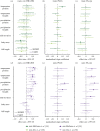Morphology and niche evolution influence hummingbird speciation rates
- PMID: 37072043
- PMCID: PMC10113027
- DOI: 10.1098/rspb.2022.1793
Morphology and niche evolution influence hummingbird speciation rates
Abstract
How traits affect speciation is a long-standing question in evolution. We investigate whether speciation rates are affected by the traits themselves or by the rates of their evolution, in hummingbirds, a clade with great variation in speciation rates, morphology and ecological niches. Further, we test two opposing hypotheses, postulating that speciation rates are promoted by trait conservatism or, alternatively, by trait divergence. To address these questions, we analyse morphological (body mass and bill length) and niche traits (temperature and precipitation position and breadth, and mid-elevation), using a variety of methods to estimate speciation rates and correlate them with traits and their evolutionary rates. When it comes to the traits, we find faster speciation in smaller hummingbirds with shorter bills, living at higher elevations and experiencing greater temperature ranges. As for the trait evolutionary rates, we find that speciation increases with rates of divergence in the niche traits, but not in the morphological traits. Together, these results reveal the interplay of mechanisms through which different traits and their evolutionary rates (conservatism or divergence) influence the origination of hummingbird diversity.
Keywords: Trochilidae; diversification; dynamic traits; evolutionary divergence; niche conservatism.
Conflict of interest statement
We declare we have no competing interests.
Figures


References
-
- Simpson GG. 1953. The major features of evolution. New York, NY: Columbia University Press.
-
- Owens IPF, Bennett PM, Harvey PH. 1999. Species richness among birds: body size, life history, sexual selection or ecology? Proc. R. Soc. B 266, 933-939. (10.1098/rspb.1999.0726) - DOI
-
- Rolland J, Salamin N. 2016. Niche width impacts vertebrate diversification. Global Ecol. Biogeogr. 25, 1252-1263. (10.1111/geb.12482) - DOI
Publication types
MeSH terms
LinkOut - more resources
Full Text Sources
Research Materials
